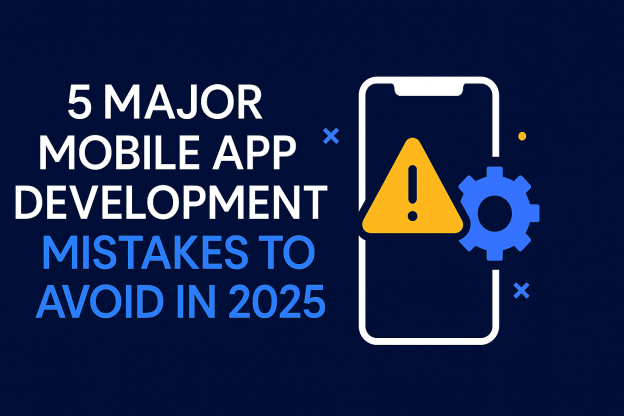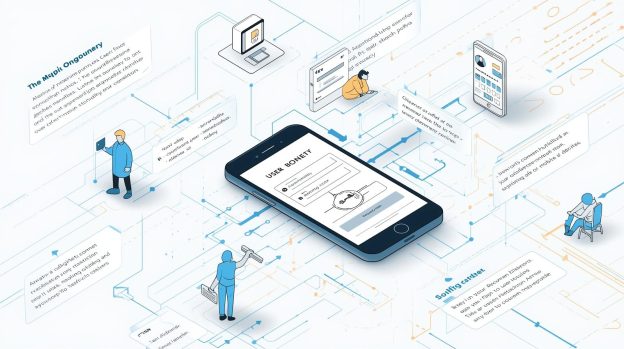5 Major Mobile App Development Mistakes to Avoid in 2025

Imagine a world without mobile applications. You can’t, can you?
Mobile applications are fundamentally shaping our world as we know it. We avail services just by a click on our mobile phones. Be it your routine grocery deliveries, booking cabs or online shopping spree, all of it is accessible through mobile apps. Customers focus on a lot of elements when using a mobile app. For instance, when you look for apps providing instant grocery delivery, you will find many applications providing the same service.
But what makes customers choose one app over another? Customers reject some apps due to limited user-friendliness, some due to their features, and some are rejected because of their performance.
As per a Statista report, mobile users spent more than a trillion hours on mobile apps in 2024. Mobile applications are in a brutally competitive market in 2025. Every brand needs a strategic advantage to make its application stand out. For businesses and brands, it’s a customer-centric world. If you are providing what your average customer wants, you win.
In this article, we will uncover the top 5 mistakes to avoid for mobile app development in 2025. It entails what you need to do differently to meet customer needs and expectations. We will focus on the mistakes that cost you money, time and your reputation. Let’s dive into it.
5 Common Mistakes to Avoid When Making a Mobile App
The market for mobile apps keeps growing and changing over time. There are thousands of mobile apps which are launched every day on Apple’s App Store and Google Play Store. Mobile apps generated over $935 billion in revenue in 2024, as per a Statista report. Learn what you may be doing wrong and adopt the recommended strategies to boost your app growth.
1. Not Adapting to Changing Market Trends
The first and foremost mistake many businesses make is not adapting to changing market trends. Some mobile apps fail because customers cannot resonate with them. Application development is not a one-time event. If you think your job is done after launching the app, you are wrong.
App development is an iterative process. You need to be aware of the changing market trends, your competitors and the new services offered in similar applications. You need to continuously make updates in the application to meet your customers’ demands.
Let’s take the example of the Tata Neu app, launched in India in April 2022. Tata describes the app as the first super app launched in India. It provides a blend of different services like e-commerce, flight booking, financial services, health and wellness and loyalty programs. The app struggles to adapt to new market trends. There are execution flaws in the Tata Neu app that restrict its appeal to customers. One of the flaws is that the Tata Neu app has different interfaces depending on the services. Hence, users have to navigate between different brands’ interfaces listed under Neu. With different brand segregation, the app does not provide a unified experience to customers, which is frustrating for most.
Tata is a pioneer in the Indian market, known for its competitive pricing, customer-centric approach, and brand trust. However, the Tata Neu app failed to meet the changing market trends due to a number of reasons. At a time when brands focus on taking a customer-first approach, Tata Neu fails to meet the mark. By shifting from a profit-first approach to a customer-first strategy, Tata Neu can create a customer appeal in the Indian market.
2. Weak UI/UX Design
The second mistake app developers make is not prioritising the UI/UX design. What looks good sells well. If you are choosing UI/UX for your mobile application without making it a priority, customers are going to notice.
You may think that customers will focus on the service/product more than they pay attention to the app’s UI. But it’s not true. For example, multiple users posted reviews on the IRCTC railways app and banking apps for their bad UI. The user interface is the face of your app that leaves a first impression on users. If you are focusing too much on the features but ignoring the UX completely, you are making a mistake.
Some of the UI/UX mistakes include an overly crowded interface. Placing a lot of information on a single screen confuses users. Cluttered or inconsistent UI instantly feels untrustworthy. It’s important to keep a clean, consistent and minimalistic UI. Apart from UI, you must also focus on UX (user experience). User Experience deals with the overall accessibility, usability, and how users will feel when interacting with the app interface.
Some apps provide seamless accessibility and interactions like Spotify. The UX of Spotify provides seamless navigation, intuitive design and personalisation. Similarly, Netflix’s app interface is smooth, clean and easy to navigate. Netflix also employs personalisation for users, providing content recommendations based on their interaction with the app. Users can find content on both platforms with utmost ease, and that’s the power of a strong UX. UI/UX is not only about providing good design and aesthetics in the app. It’s also about making the whole customer journey easy. Ever wondered why using Instagram feels effortless? It’s because of its strong UI/UX. Instagram continuously upgrades its design and features, which doesn’t disappoint its 2 billion users.
3. Not Prioritising Cross-Platform Compatibility
Imagine you spend a hefty sum of money on a full-fledged mobile app, but half your audience can’t even download it on their mobile devices. The developer created the application to run on Android devices. This happens when you don’t pay attention to cross-platform compatibility.
But what is cross-platform compatibility when it comes to mobile app development? When developers create an application using native coding technologies, it requires a separate codebase for each platform. It means that developers need a Java/Kotlin codebase for the Android OS and Swift/Objective-C for iOS OS. But cross-platform app development allows developers to create a single application. Cross-platform development provides a shared codebase through which the application can run on both Android and iOS.
Cross-platform app development eliminates the need for a separate codebase. Developers create a single codebase that works for both iOS and Android. Developers can compile the code to run on different OS. The cross-platform frameworks are React Native, Flutter, and . .NET. By doing cross-platform app development, you can save the budget and time required to develop separate codebases.
Sticking to single‑platform native code shrinks your potential market overnight. There are more than 700 million smartphone users in India. Out of this, approximately 94.68% users have Android as per Statcounter Global Stats. The estimates from Quora highlight approximately 40 million users of iOS in India. Even if you try and make a native application for the Android users, since they are a majority, you lose out on potential 40 million customers.
4. Improper Testing & Quality Assurance
Are you taking mobile app testing as a last step formality? If not, it can result in major customer dissatisfaction.
You have to consider every bad experience customers have when dealing with a poorly tested app. Customer retention is a bigger problem than you realise. Without rigorously testing every feature of the mobile app, its release may create more concerns for you. Don’t take testing as a formality. You can begin testing the app after the clickable prototypes are ready. You don’t have to wait until the end for the application development to finish. Testing should begin in iterative phases. It gives an idea of vulnerabilities, bugs and irrelevant features present in the app. Developers should adopt an agile approach to test and develop the application.
Eliminate continuous testing on emulators. Instead, you should use actual phones and devices to run the application. By distributing the application prototype to naive users at an early stage, you can find more bugs and glitches in the app code. Testing the app from an early stage will leave no scope for error. With new applications coming into the market every day, the first impression is very important. Win your customers by providing them with what they want, because they don’t usually give a second chance.
More than upsetting customers, an untested or poorly tested app can lead to extreme revenue loss. Let’s take the example of Ola’s promotional code bug from 2015. A software engineer uncovered the bug in the Ola app while he was playing around with the app interface. The user found out that he can top up his Ola wallet with any amount of money using a “first-time customer promotion” coupon any number of times. Using this, he would be able to get unlimited free cab rides from Ola. At the time, he highlighted this bug to Ola, but they ignored it. The company later resolved the bug, but it is not clear how many users took advantage of it.
Hence, the moral of the story is to ensure that your testing mechanisms are strong. Testing is a continuous process which begins from initial development to post-release maintenance.
5. Overloading the App with Features and Ignoring Scalability
Imagine this scenario – You have a very well-liked app having all the features related to your online clothing brand. You sell women’s specific merchandise, footwear and accessories. Now you want to add more features to your app, but are not able to. Alternatively, you can add new features like ‘book appointment’, but the entire app crashes.
This is an issue of Scalability. Why do you need a scalable mobile app, you ask? Well, it’s simple. Because you want to grow.
You may have started with a limited number of customers using the application. But what happens when you see a surge in demand and many customers trying to access the application at the same time? Your app crashes. This is because developers did not create it with scalability in mind.
When you design an app with a single purpose in mind, it breaks down when the number of users increases. Scalability refers to the ability of an app or website to handle increasing load, data or users without breaking down. Cloud-based application development provides immense scalability to the application. In simple words, cloud-based solutions provide data storage according to your business needs. Hence, your app will be able to grow along with your business. This allows you to create extendable apps that can accommodate a large amount of data and user needs. You can add, modify or delete any number of features in a scalable mobile app. You need an app that meets the goals of today and tomorrow.
To Sum Up
The face of application design, development, testing and release is changing in the world of technological advancements. New tools and technologies allow for seamless integration of features within mobile apps. It is the era of becoming smart with what you deliver to your customers. Understanding their requirements is key. It is crucial to invest in mobile app development with some key factors in mind. We discussed some common mistakes developers make while doing app development.
If you need experienced developers for your mobile app development, VerveLogic will be happy to assist you. Having delivered 150+ projects, VerveLogic encourages you to consult with our developers for your application development needs.
FAQs
Can I migrate the app from a native platform to a cross-platform?
Yes, absolutely. The native platform applications can be migrated to a cross-platform. This is possible by rewriting the app’s UI, data management and business logic using cross-platform technologies like React Native and Flutter.
Why use React Native instead of React?
React (or ReactJS) is used for web applications, while React Native is used for mobile application development.
Why is React Native widely used for application development?
React Native allows development for cross-platform apps, i.e., Android and iOS. It has a single codebase, which provides faster development and is easy to manage.
How much does it cost to migrate from native to cross‑platform?
Costs vary by app complexity, but cross‑platform migration often saves 30–40 % in long‑term maintenance. Contact VerveLogic for a tailored quote.




